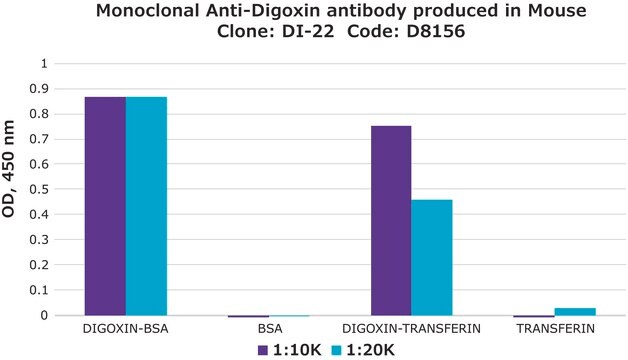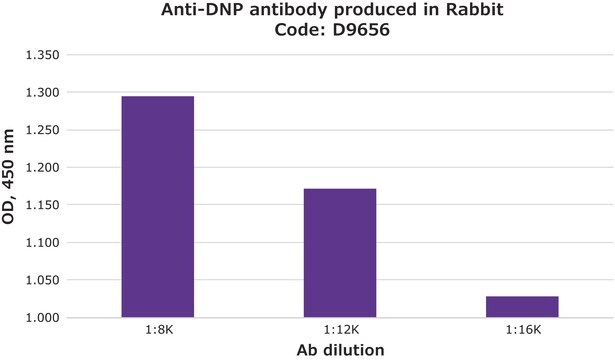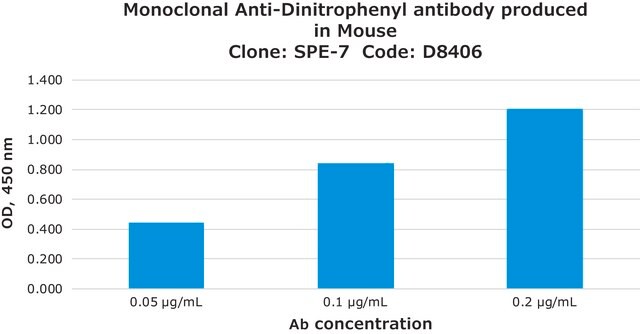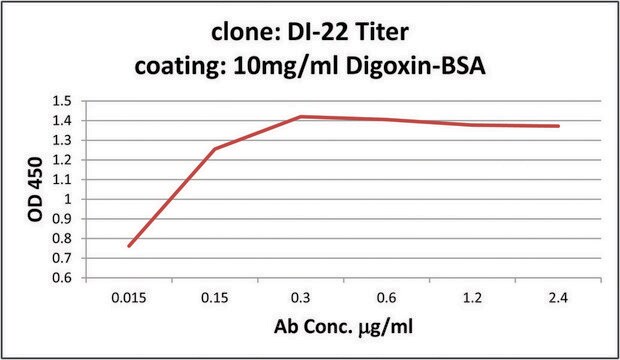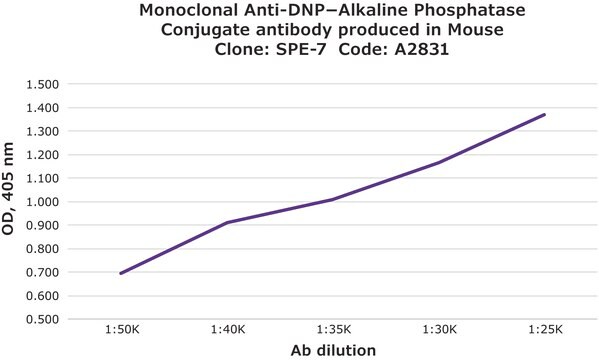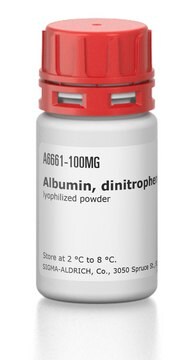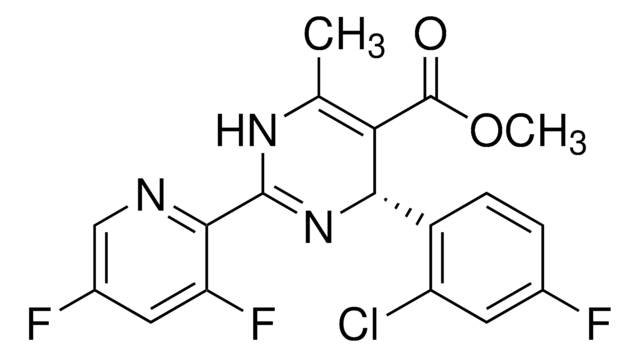D9781
Anti-DNP antibody produced in goat
whole antiserum
Synonyme(s) :
Anti-Dinitrophenol
Se connecterpour consulter vos tarifs contractuels et ceux de votre entreprise/organisme
About This Item
Produits recommandés
Source biologique
goat
Niveau de qualité
Conjugué
unconjugated
Forme d'anticorps
whole antiserum
Type de produit anticorps
primary antibodies
Clone
polyclonal
Contient
15 mM sodium azide
Technique(s)
indirect ELISA: 1:8,000
quantitative precipitin assay: 1.6-2.4 mg/mL
Conditions d'expédition
dry ice
Température de stockage
−20°C
Modification post-traductionnelle de la cible
unmodified
Description générale
Anti-dinitrophenyl (DNP) antibody is produced in goat using DNP-BSA as the immunogen. The antiserum has been treated to remove lipoproteins. The product is determined to be reactive with DNP-BSA and DNP-RSA but not BSA (bovine serum albumin) or RSA (rabbit serum albumin) by immunoelectrophoresis (IEP).
Immunogène
A DNP-BSA conjugate
Application
Anti-DNP antibody produced in goat has been used in DNA immunoFISH and for differential staining of blastocysts.
Anti-DNP antibody produced in goat was used to study the effects of IgE on the clustering of FcεRI by time-resolved phosphorescence anisotropy.
Notes préparatoires
delipidized
Remarque sur l'analyse
Antiserum is tested for specificity and titer by immunoelectrophoresis and quantitative precipitin techniques.
Clause de non-responsabilité
Unless otherwise stated in our catalog or other company documentation accompanying the product(s), our products are intended for research use only and are not to be used for any other purpose, which includes but is not limited to, unauthorized commercial uses, in vitro diagnostic uses, ex vivo or in vivo therapeutic uses or any type of consumption or application to humans or animals.
Vous ne trouvez pas le bon produit ?
Essayez notre Outil de sélection de produits.
Code de la classe de stockage
10 - Combustible liquids
Classe de danger pour l'eau (WGK)
nwg
Point d'éclair (°F)
Not applicable
Point d'éclair (°C)
Not applicable
Faites votre choix parmi les versions les plus récentes :
Déjà en possession de ce produit ?
Retrouvez la documentation relative aux produits que vous avez récemment achetés dans la Bibliothèque de documents.
Les clients ont également consulté
Miguel A Velazquez et al.
Biochimica et biophysica acta, 1864(2), 590-600 (2017-12-03)
Mouse maternal low protein diet exclusively during preimplantation development (Emb-LPD) is sufficient to programme altered growth and cardiovascular dysfunction in offspring. Here, we use an in vitro model comprising preimplantation culture in medium depleted in insulin and branched-chain amino acids
Jinming Song et al.
Biochemistry, 41(3), 881-889 (2002-01-16)
Rat mucosal-type mast cells of the RBL-2H3 line express a glycoprotein termed the MAst cell Function-associated Antigen (MAFA). When MAFA is clustered by its specific monoclonal antibody G63, secretion normally triggered by aggregating these cells' type I Fcepsilon receptor (FcepsilonRI)
M A Velazquez et al.
Human reproduction (Oxford, England), 31(9), 1970-1980 (2016-07-13)
Does advanced maternal age (AMA) in mice affect cardiometabolic health during post-natal life in offspring derived from an assisted reproduction technology (ART) procedure? Offspring derived from blastocysts collected from aged female mice displayed impaired body weight gain, blood pressure, glucose
Jinming Song et al.
Molecular immunology, 38(16-18), 1315-1321 (2002-09-10)
Clustering the mast cell function-associated antigen (MAFA), a membrane glycoprotein expressed on 2H3 cells, by its specific monoclonal antibody G63 substantially inhibits secretion normally triggered by aggregating these cells' Type I Fcepsilon receptor (FcepsilonRI). To explore possible MAFA-FcepsilonRI interactions giving
Shohreh Majd et al.
Current Alzheimer research, 15(8), 764-776 (2018-02-24)
Emerging evidence supports the hypothesis that metabolism dysfunction is involved in pathogenesis of Alzheimer's disease (AD). One aspect of metabolic dysfunction includes dysregulation of adenosine monophosphate kinase protein kinase (AMPK) and mammalian target of rapamycin (mTOR) metabolic axis, which is
Notre équipe de scientifiques dispose d'une expérience dans tous les secteurs de la recherche, notamment en sciences de la vie, science des matériaux, synthèse chimique, chromatographie, analyse et dans de nombreux autres domaines..
Contacter notre Service technique